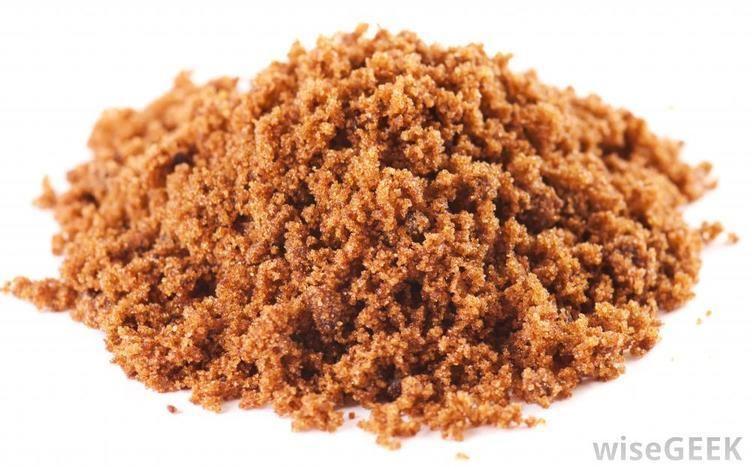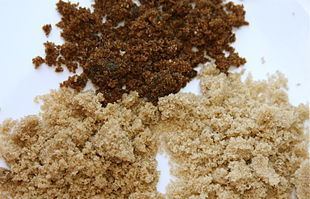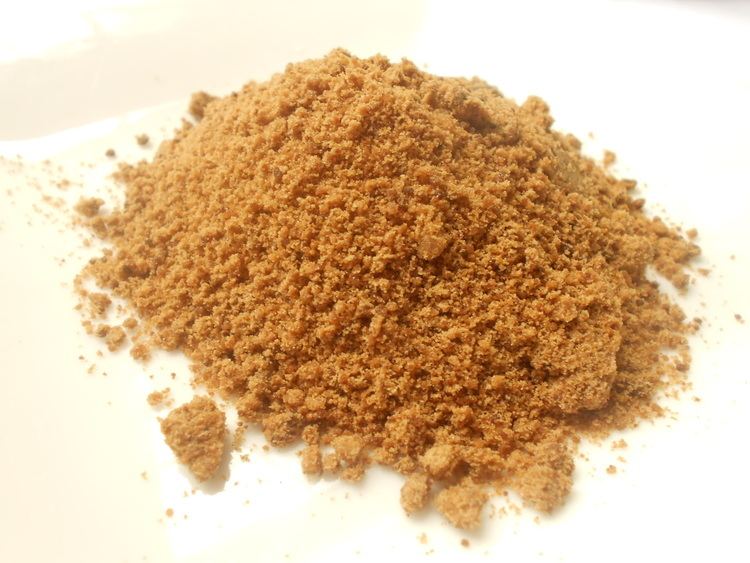 | ||
Similar | ||
Muscovado, called Khaand in Hindi language, is a type of partially refined to unrefined brown sugar with a strong molasses content and flavour. It is technically considered either a non-centrifugal cane sugar or a centrifuged, partially refined sugar according to the process used by the manufacturer.
Contents

Confusion has been created over the meaning of the term muscovado sugar, and as there is no legal definition or Protected Designation of Origin (PDO), different manufacturers are free to use the term loosely to describe any dark, molasses-rich sugar they produce. The term was originally coined in 17th- to 18th-century English to designate a poorly refined sugar that had retained too high a content of molasses and was deemed low quality.

In a modern context muscovado is used to define sugar made from the juice of sugar cane by evaporation until crystallization occurs. This solution of crystals and mother liquor (molasses) is called massecuite. The massecuite is set into moulds directly, granulated in cooling pans by shear action (either the traditional manual method or through use of a spray drier) or sent to a centrifuge to separate a crystal-rich mush that is drained of its molasses in a vessel under gravity.

Currently there are two localities still producing a commercial sugar termed muscovado, Mauritius and the Philippines. Muscovado from Mauritius is produced by centrifuged massecuite left to drain naturally of its molasses, whilst Filipino muscovado may be generated from any of the three methods. Trade aid distributes Muscovado sugar produced by small scale producers of the Norandino co-operative in northern Peru.

There is some effort being made to clean up the terminology of sugars produced over the world as there are various synonyms used to describe unrefined through poorly refined to partially refined sugars with high molasses content and a dark colour made from sugar cane, such as panela (Colombia, Ecuador, Guatemala, Argentina), rapadura (Brazil), chancaca (Chile, Peru, Bolivia), piloncillo (Mexico), muscovado (Philippines, Mauritius), panocha (Philippines), raspadura (Panama), kokuto (Japan), jaggery (India, South Africa, Kenya, Nigeria) and papelon (Venezuela)

Cooking with australian muscovado sugar video
History
Also known as "Barbados sugar", "molasses sugar" or "moist sugar", muscovado sugar is an English corruption of the Spanish azúcar mascabado or the Portuguese açúcar mascavado, meaning sugar of the lowest quality or lowest value. The name and meaning is tied to the state of sugar production and markets of the late 18th to earliest 19th century, when sugar that had been less refined was considered an inferior product by the industry; thus muscovado meant literally a low quality sugar that was poorly drained of its molasses.
Throughout the British Empire sugars that had been refined enough to lose most of their molasses content were termed raw and deemed higher quality, while most poor quality sugars with a high molasses content were usually referred to as muscovado, though the term "brown sugar" was occasionally used interchangeably. Sugar in the 19th century was produced through a variety of methods ranging from traditional, outdated practices, through to more modern, industrialized methods which incorporated the latest technology, such as vacuum pans and centrifuges. Sugar imported into Britain from its colonies (the West Indies, Mauritius and India) or from foreign markets (Cuba, Java, Brazil, Puerto Rico, the Philippines, Réunion, Louisiana or the French West Indies) was brought to port in a variety of purities that could be sold either as raw sugar direct to market or as muscovado bound for a British refinery such as those in Glasgow or London. Sugar refinement had reached a zenith in Britain (and also, incidentally, in Louisiana), so expensive industrial equipment did not need to be installed in the colonies. In the early 19th century muscovado sugar was being produced in Mauritius from centrifuges and sent to conical moulds, in which molasses dripped from the sugar crystals under gravity. At the same time muscovado was being produced in the West Indies by primitive shearing action (feet stamping into barrels) on clarified, evaporated cane juice. Both of these are examples of the divergent production methods used to make muscovado sugar.
Uses
Muscovado is very dark brown and slightly coarser and stickier than most brown sugars. Muscovado takes its flavor and color from its source, sugarcane juice. It offers good resistance to high temperatures and has a reasonably long shelf life. It is commonly used in baking recipes and making rum. Muscovado sugar can be used in most recipes where brown sugar is called for, by slightly reducing the liquid content of the recipe.
Muscovado sugar has 11 calories/ 4 grams (approx. 1 tsp). When produced under regulated conditions, it is nutritionally richer than other brown sugars or refined sugar, and retains most of the natural minerals inherent in sugarcane juice, as shown in this chart:
Mineral content of muscovado sugar (per 100 g):
This unrefined sugar can be used in coffee and other beverages, and was one of the most prominent export commodities of the Philippines, especially from the Negros region from the 19th century until the late 1970s. The production of muscovado sugar in the Philippines, Barbados, and elsewhere had experienced a long period of decline when large mills took over sugar production from small farmers with small mills until consumer interest in healthy and organic foods revived interest in muscovado sugar, creating a new market for muscovado sugar production from small mills.
